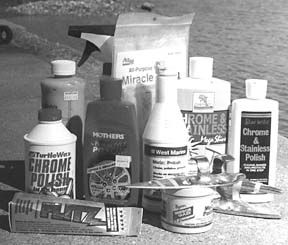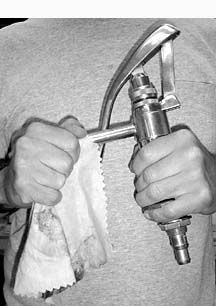
Gone are the days when bright chrome metal gleamed from just about everywhere on a boat, and “chrome-plated” was synonymous with quality. The fact is that chrome doesn’t stand up well to the marine environment, especially in saltwater areas, and hardier stainless steel and aluminum have replaced chrome for many applications, especially for bow rails, cleats, and rub and trim rails.
So why is the market still flooded with chrome cleaners? Well, a look at any current marine gear catalog reveals that there still are many items on a boat that might be chrome or, more accurately, chrome-plated zinc or bronze. Here’s a short list, but you might want to take an inventory on your own boat.
Many of the smaller hardware items on deck are chrome-plated, although in many cases stainless steel or plastic composite alternatives are available. We’re talking about such things as deckplates, lift rings and handles, and cable outlets. A surprising number of fasteners – barrel and ship bolts, hasps, fender hooks, and ladder mounts – are chrome. Fold-down swim steps, step plate frames, and antenna mounts may also be chrome. And chrome is still a common metal used for many brand-name running light casings.
Hard to believe at this point, but chrome plating (actually a thin coating of chrome over an in-between layer of nickel) was intended to cut down maintenance on such easily tarnished metals as iron and the copper alloys. Unfortunately, there are various quality levels to chrome and, as with stainless steel, much of what is found on marine gear is likely to be less than marine-grade.
Today we know that the presence of chrome, or chromium, plating means increased maintenance for the boat owner who wants to keep things bright and shiny, not to mention functioning. Neither as corrosion-resistant or forgiving as marine-grade stainless or aluminum, a chrome surface tarnishes easily, and mild corrosion and oxidation can quickly develop into terminal pitting and crazing. There’s still a measure of protection being given to underlying metal – but who needs this? The ideal solution would be to replace chrome fittings with stainless or aluminum, where appropriate, as soon as their appearance falls off. In the meantime, there are some dedicated (though not very) cleaners out there.
Chrome Cleaners
As far as we can tell, there’s nothing special about a “chrome” polish, which is generally no different than a stainless or all-purpose metal cleaner/protector. Like most metal polishes, they tend to come in either liquid-cream or paste form. The latter is less messy to work with in most cases. Active ingredients – petroleum distillates, ammonia, or alcohol – act as solvents, sometimes combined with a fine abrasive, such as DE (diatomaceous earth), that handles oxidation. Cleaners do vary in quality, and some of the better ones also contain protective coatings and, mild fragrances. The fragrances that are meant to be pleasant are probably put there to mask what the manufacturers think would be the less pleasant odors of the raw chemicals. In some cases we’re not sure which is more objectionable. Coatings, meant to deter further soiling, vary from waxes to synthetic films, such as Star brite’s Teflon-based polymer.
We checked the marine catalogs and chandleries, both chain and local, as well as auto-supply stores, where prices tend to be lower. Our choices ranged in price from $1.99 to $11.95; however, the cost-per-ounce varied considerably, as did the effectiveness of the product.
How We Tested
We tried each of the cleaners at least three times, once on the chrome trim of a vintage Columbia bike and also on several chrome-plated cleats that had seen shinier days. For each test, we used clean white cotton rags – one to apply, one to wipe off – for each cleaner, making sure there was no cross-pollution. We followed manufacturers’ instructions precisely but also made several applications if the situation warranted.
What We Found
Unlike our tests of other metal polishes, including those for stainless or brass or bronze, we found no magic bullet, no clear-cut winner. Most of what we tried did an OK job of polishing undamaged chrome surfaces. None seemed to have much effect on really degraded areas – a result we’d blame on the nature of chrome rather than the cleaners themselves. We did find some easier (less messy) and/or pleasant (less odoriferous) products. Generally, we preferred using the pastes, which were less runny and also less inclined to seep into crevices or screw holes. Given the range of prices, there are some we’d rate a Best (or at least Better) Buy, other things being equal. Finally, we also used a Miracle Cloth, marketed under West Marine’s SeaFit line, which was the easiest of all the products to use, didn’t require the use of separate rags, and was among the best performers.
Here are the details and some comments on the various cleaners we tried. Note: Prices cited are what we paid; you may find better.
Results
Among the liquid pastes, we liked three from the marine field: Star brite’s Chrome & Stainless Polish ($5.55/8 oz.), the very similar West Marine One Step Metal Polish ($6.99/pint), and Dolphinite’s Chrome & Stainless Mega Shine ($11.95/pint). All were easy to work with – for liquids – while the Dolphinite seemed to be slightly more fragrant. We tested two versions of this polish; a new one came into the market during our testing. According to company spokesman Adam Boulay, the liquid contains two UV blockers, carnauba wax, Trinite, a moisturizer, and a new ingredient, Aluminator, which breaks down corrosion chemically. Overall, we’d have to say the new Dolphinite was the best of the liquids – and pastes.

Collinite makes a great boat wax, but its #850 Metal Wax did not appear particularly effective and, at $10.95/pint, is fairly expensive as well. Even more expensive (we paid $9.99 for a 1.7 oz. tube) was Flitz Metal Polish, Fiberglass and Paint Restorer, a grayish-blue paste that produced so-so results. To our nose, the active ingredient appears to be ammonia, but, probably because it’s intended for fiberglass surfaces as well as metal, it contains no abrasives or acids.
As we mentioned, the pastes were more pleasant to work with but not noticeably more effective at restoring a shine than the liquids. Meguiar’s All Metal Polish ($7.99/5 ounces) was described by a company spokesperson as a “physical polisher,” meaning, to us, that its synthetic abrasive micro-particles do the bulk of the work. It also has a pleasant fragrance, unlike the Mothers Mag & Aluminum paste ($3.99/5 ounces) recommended to us by an auto store clerk. The Mothers resembled cottage cheese that has been left in the fridge too long (the liquid separating from the solids) and had a strong petroleum odor; nor was it especially effective. We also tried Mothers Chrome Polish ($2.99/8 fl. oz.) It both smelled a little better and seemed a bit more effective.
Another liquid that worked reasonably well on undamaged chrome was Turtle Wax Chrome Polish, which also appeared to have an ammonia base. At $1.99 per 12 fl. oz, we’d call this a Best Buy among the liquids and recommend it for light cleanups of undamaged chrome. Otherwise, for cleaners, we’d go with the Dolphinite or West (a better bargain than the Star brite) among the liquids, and Meguiar’s for the pastes.
Still, we prefer the Miracle Cloth ($4.99 at West) over any other product. The cloth contains a fine micro-abrasive (the cotton fabric itself acts as an abrasive), with a 14% ammonia content, lemon oil, and liquid wax that forms a seal. We found it easiest to use – which means we’d be more likely to use it often – and quite effective. In fact, when we went over chrome areas previously “cleaned” with other products, the cloth picked up dark smudges, a sure sign more cleaning was needed. Another advantage is that it doesn’t leave a residue in cavities like some of the cleaners, especially the liquids. Smudged or not, the cloth can be reused, and we’ve found it good for cleaning stainless steel and other metals.
Contacts – Collinite, 315/732-2282, www.collinite.com; Dolphinite, 978/356-9834, www.dolphinite.com; Flitz International, 800/558-8611, www.flitz.com; Meguiar’s, 800/347-5700, www.meguiars.com; Mothers, 714/891-3364, www.mothers.com; Star brite, 800/587-2813, www.starbrite.com; Turtle Wax, 708/563-3559, www.turtlewax.com; West Marine, 800/262-8464. www.westmarine.com.



































